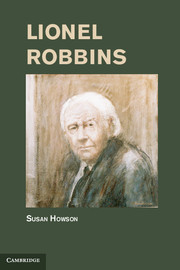Book contents
- Frontmatter
- Contents
- Illustrations
- Abbreviations
- Introduction
- One Father and Son
- Two The Great War
- Three Postwar
- Four The London School of Economics
- Five Iris Gardiner
- Six New College Oxford
- Seven The Young Professor
- Eight Fritz and Lionel
- Nine The School in the Mid-1930s
- Ten The Approach of War
- Eleven The Economics of War
- Twelve Director of the Economic Section
- Thirteen Anglo-American Conversations
- Fourteen The Law Mission and the Steering Committee
- Fifteen 1 9 4 4
- Sixteen The Last Months of the War
- Seventeen The Postwar Settlement
- Eighteen Return to the School
- Nineteen The End of the Transition
- Twenty LSE in the Early 1950s
- Twenty-One Chairman of the National Gallery
- Twenty-two Lord Robbins
- Twenty-three The Robbins Report
- Twenty-four The Sixties
- Twenty-five The Arts
- Twenty-six The Troubles at LSE
- Twenty-seven Retirement
- Conclusion
- Bibliography
- Index
Fourteen - The Law Mission and the Steering Committee
Published online by Cambridge University Press: 07 October 2011
- Frontmatter
- Contents
- Illustrations
- Abbreviations
- Introduction
- One Father and Son
- Two The Great War
- Three Postwar
- Four The London School of Economics
- Five Iris Gardiner
- Six New College Oxford
- Seven The Young Professor
- Eight Fritz and Lionel
- Nine The School in the Mid-1930s
- Ten The Approach of War
- Eleven The Economics of War
- Twelve Director of the Economic Section
- Thirteen Anglo-American Conversations
- Fourteen The Law Mission and the Steering Committee
- Fifteen 1 9 4 4
- Sixteen The Last Months of the War
- Seventeen The Postwar Settlement
- Eighteen Return to the School
- Nineteen The End of the Transition
- Twenty LSE in the Early 1950s
- Twenty-One Chairman of the National Gallery
- Twenty-two Lord Robbins
- Twenty-three The Robbins Report
- Twenty-four The Sixties
- Twenty-five The Arts
- Twenty-six The Troubles at LSE
- Twenty-seven Retirement
- Conclusion
- Bibliography
- Index
Summary
Lionel Robbins was soon on his way to North America again. After he left Washington in June 1943, discussions on the Stabilization Fund continued between Robertson and Bernstein, while Keynes in London tried to combine his and White’s plans, taking as his starting point the minimum American requirements outlined by White to Phillips, Opie, Robertson and Robbins (JMK 25, 300–14). On the commercial policy front there had been developments while Lionel was in America. The renewal of the Reciprocal Trade Agreements Act in June made it likely that the US Administration would soon ask for talks under Article VII. In London there had been discussions on postwar commercial policy with representatives of the Dominions and India which concentrated on the Meade plan for a Commercial Union (Pressnell 1986, 108–9; PCP(43)5, Summary of Discussions between Officials of the United Kingdom, the Dominions and India held in London in June 1943, T230/129). After the diplomatic success of the British delegation at Hot Springs the time seemed ripe for ‘an attempt to reach preliminary agreement with the United States Government on all the subjects covered by Article 7 of the Mutual Aid Agreement, principally monetary policy, international investment, the regulation of primary products and commercial policy’, as Eden, Wood and Dalton advised their fellow ministers (Memorandum by the Secretary of State for Foreign Affairs, the Chancellor of the Exchequer and the President of the Board of Trade, T230/92). The War Cabinet agreed on 27 July to take the initiative in proposing ‘informal and exploratory talks’ with the USA in September. The Americans agreed early in August.
While Robbins was away, ministers had considered the Economic Section paper on postwar employment policy (PR(43)26, The maintenance of employment, 18 May 1943, CAB87/13). It had provoked a strong and hostile reaction in the Treasury. Hopkins characterized it to the Chancellor of the Exchequer on 26 May (T161/1168/S52098) as ‘unlike all their other products…a bad paper, academic, misleading and dangerous’. It was dangerous (from the Treasury point of view) because it left the ‘general impression…that the Economic Section think that the maintenance of full employment can be taken care of almost entirely by Treasury policies alone’: the Chancellor should not ‘pass it over with an initial compliment and no qualifications’. Hopkins’s colleagues, especially Henderson, produced numerous objections, which Keynes and Meade tried to counter without success (JMK 27, 320–6; Meade to Henderson, 25 May, Henderson to Meade, 27 May 1943, T230/66). Wood accordingly told the ministerial Committee on Reconstruction Priorities on 31 May (PR(43)11th meeting, CAB87/12) that he ‘thought that the Memorandum went too far in the direction of treating unemployment as a single problem for which one solution could be found’, that he intended to circulate his own memorandum, and that he did not accept the assumptions or the conclusions of the Section paper. Other ministers, notably Bevin and Dalton, were more sympathetic. At the same time they thought the Economic Section had not taken sufficient account of the problem of unemployment in the depressed areas of Britain. There was ‘general agreement’ only with the proposition that ‘every practicable step’ should be taken to encourage investment as soon as depression threatened.
- Type
- Chapter
- Information
- Lionel Robbins , pp. 462 - 494Publisher: Cambridge University PressPrint publication year: 2011

